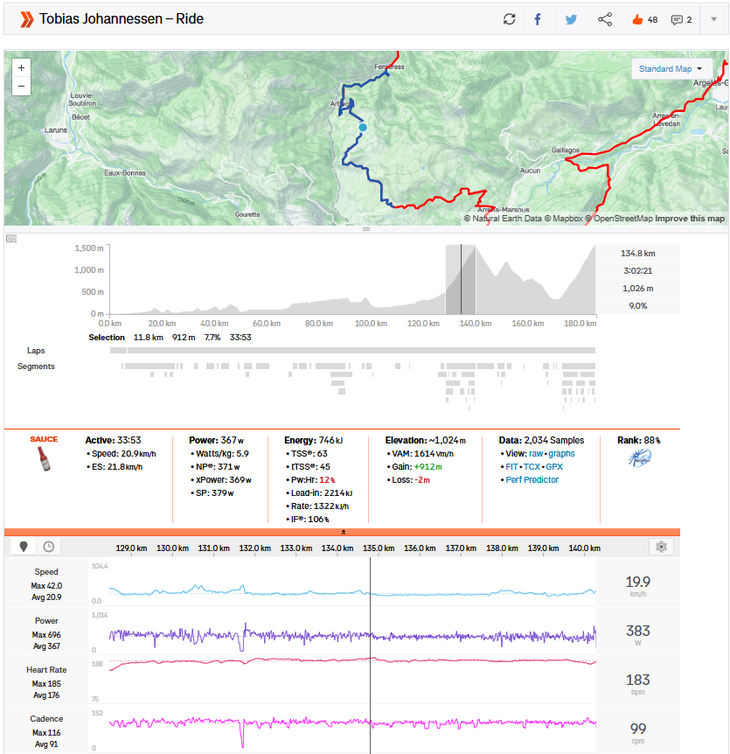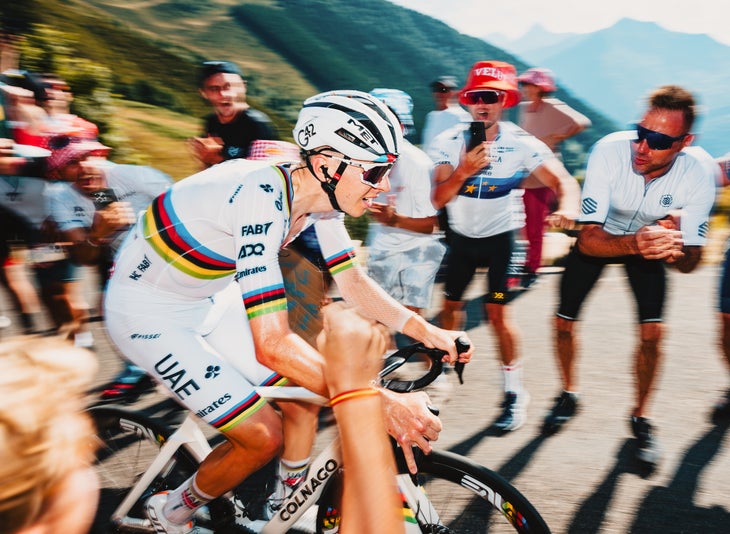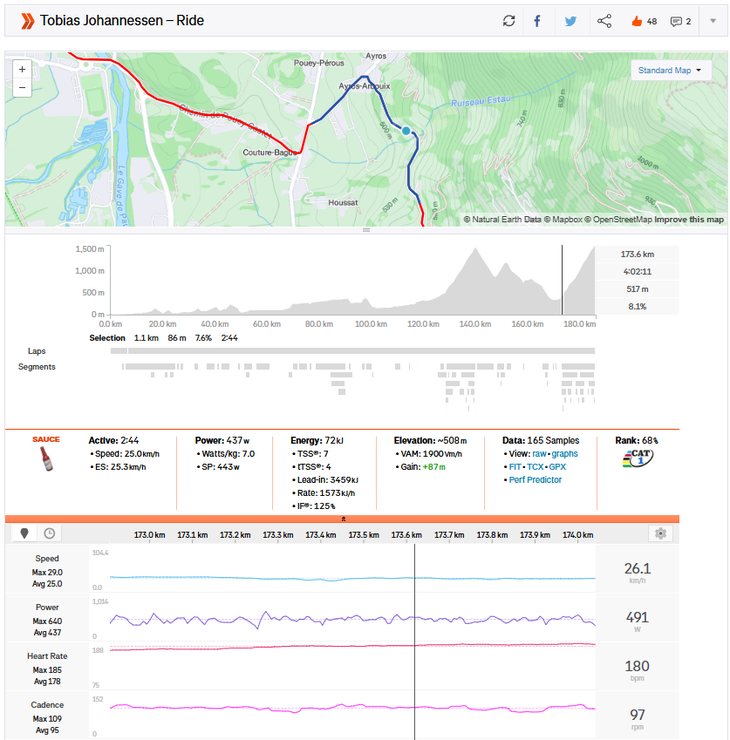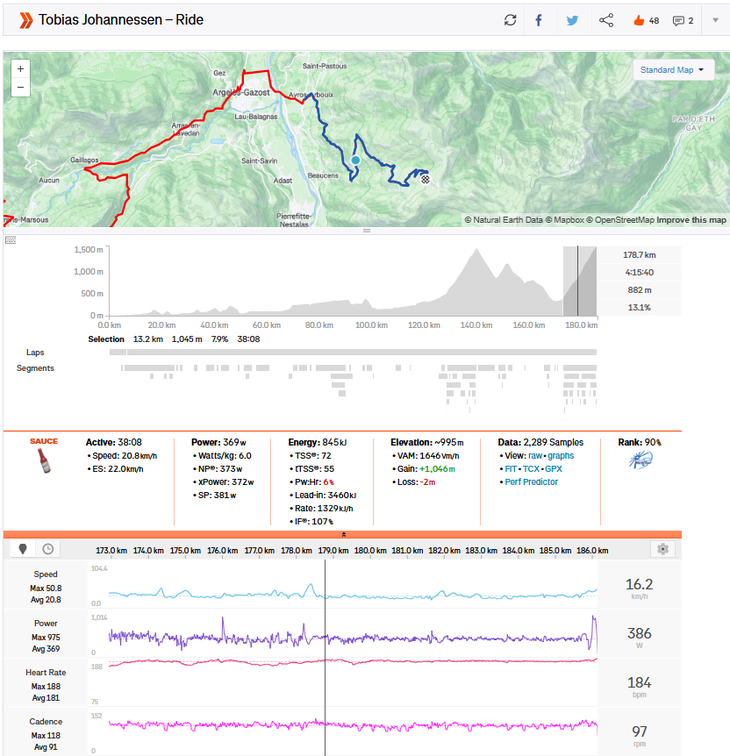“], “filter”: { “nextExceptions”: “img, blockquote, div”, “nextContainsExceptions”: “img, blockquote, a.btn, a.o-button”} }”>
Every time Tadej Pogačar attacks, we are witnessing cycling history. Sometimes, he is winning another monument; other times he is dropping the likes of Remco Evenepoel or Mathieu van der Poel. Today, he nearly set the all-time climbing record on Hautacam on stage 12 of the Tour de France.
Pogačar put more than two minutes into his rivals despite crashing in the previous stage. Jonas Vingegaard doesn’t seem to be at his best level. But Florian Lipovitz certainly is. Evenepoel ate more wind than any other GC contender, yet, he is still in the fight for the GC podium.
Stage 12 of the Tour de France on Hautacam
After countless attacks from kilometer zero, a massive breakaway of 51 riders formed in the early parts of stage 12. Among them were multiple riders from Lidl-Trek, EF Education-EasyPost, Israel-Premier Tech, and more. UAE Team Emirates-XRG shared the pacemaking in the peloton with UNO-X Mobility who were defending Tobias Halland Johannessen’s Top-10 in the GC.
The breakaway averaged nearly 50 kph for two and a half hours of the stage. But the peloton was only two minutes behind. This meant that the GC riders didn’t arrive completely fresh to the bottom of the first climb, the Col du Soulor (11.8 km at 7.6%).
While the breakaway battled for the KOM points, Visma Lease-a-Bike began setting a vicious pace in the peloton. This was the hardest climbing pace that we’ve seen so far in this Tour de France. It was so hard, in fact, that Evenepoel and Matteo Jorgenson dropped out of the GC group.
In response, Visma LAB abandoned their pacemaking strategy and slowed things down. You can see this moment clearly in the Strava files of Johannessen and Onley — roughly halfway up the climb, the pace eases from 6.2w/kg to 5.6w/kg. Their heart rates drop by nearly 10 bpm, and a number of riders catch back on to the GC group before the descent.

Johannessen and GC group – Col du Soulor
- Time: 33:53
- Average Power: 367w (5.9w/kg)
- First half: 17min at ~6.2w/kg
- Second half: 17min at ~5.6w/kg
- VAM: 1,614 Vm/h
The descent of the Col du Soulor didn’t last long because there was only 7km until the start of the Category 2 Col des Bordères (3.3km at 8.1%). Again, there was a hard start to the climb with Visma LAB and UAE Team Emirates-XRG pacing at over 6w/kg. But when Jorgenson started losing contact with the group, the pace slowed to 5.6w/kg.
These two climbs could have been a turning point in the race if Visma LAB had continued to pace on the Col du Soulor. If Simon Yates and Sepp Kuss had continued pulling at nearly 6.5w/kg, would the result have been the same at the top of Hautacam?
So there it was, the mythical climb that has featured for decades in the Tour de France. At 13.5 km with an average gradient of 7.9%, Hautacam is one of the hardest climbs in this year’s Tour. It is not a steady gradient, either. The lower slopes are more forgiving, averaging 6-8% for the first few kilometers. But halfway up, there is a 2km section with an average gradient over 10%. Those who burn their matches early could lose heaps of time. Attacking from the bottom would be an incredibly risky strategy.
In steps Tadej Pogačar, a rider so crazy that he will attack with 100 km to go in the road world championships…and win.
After a ridiculous leadout from UAE Team Emirates-XRG, Pogačar attacked just a few hundred meters into Hautacam. Tim Wellens had taken the first pull, and then it was Jhonatan Narváez who launched the world champion into orbit. Adam Yates had already been dropped, and who knows how fast Pogačar would have gone if João Almeida had been there to give him a pull.
When Narváez was doing the final leadout, only Vingegaard was left on Pogačar’s wheel. Everyone else – Evenepoel, Florian Lipovitz, Primož Roglič, Oscar Onley, Kévin Vauquelin, Johannessen, etc. – were already out of the camera shot.
This has become the Tadej Pogačar special: UAE Team Emirates-XRG leads it out at 50 kph into a 20+ minute climb. Everyone is afraid of blowing up during such a long effort, so why not make their legs explode in the first 500 meters? Pogačar’s teammates do 20-30 second pulls at 600-700w (~9 to 10w/kg), a pace so ridiculous that few dare to follow it.

At that speed, Pogačar doesn’t even need to accelerate to attack. If he can just maintain 9-10w/kg for another 30 seconds, there won’t be anyone left on his wheel. That is part of the reason why we’ve seen him attacking in the saddle recently. With a lead out that strong, Pogačar doesn’t even need to sprint to open a gap. Ninety-nine percent of the damage has already been done in the lead out.

Johannessen – Following the Team UAE Emirates-XRG Lead Out
- Time: 2:44
- Average Power: 437w (7w/kg)
- VAM: 1,900 Vm/h
- Average Speed: 25 kph up at 7.6% grade
Once Pogačar attacked, there was only one rider who could challenge him: Jonas Vingegaard. The Dane kept the world champion in sight for a few minutes, but then the gap started to grow. Ten seconds…20 seconds…30 seconds…then a minute.
By the time they reached 2km to go, Vingegaard was nearly two minutes behind Pogačar. In fact, the Dane was losing time to Lipovitz, who was in third place on the road. By the time Pogačar crossed the finish line, Vingegaard was 2:10 behind, with Lipovitz in third at 2:23. Johannessen outsprinted Onley for fourth, while Vauquelin and Evenepoel finished sixth and seventh, respectively.
Pogačar’s official time on Hautacam: 35 minutes and 8 seconds.
This was the fastest ascent of Hautacam since the 1990s, when Bjarne Riis set the record with a time of 34:38. Vingegaard was actually slower than his Pogačar-dropping ride in 2022 (which came after a harder day of climbing, but later in the race). It’s a performance that will leave Visma LAB scratching their heads as to what went wrong.
Lipovitz did the best climb of his career to finish third, while Evenepoel is clearly a few steps below his 2024 climbing level. There were a few other standout performances from Hautacam, both good and bad.
Vauquelin proved that he is far more than a world-class puncheur by finishing sixth, while Jorgenson had a horrible day, losing over 10 minutes and falling out of the GC. Johannessen showed that the Critérium du Dauphiné was no fluke, and Narváez did one of the best climbing performances of his career. Who would have guessed the Ecuadorian puncheur would be Pogačar’s final lead out man on Hautacam?

- Johannessen – Hautacam
- Time: 38:08
- Average Power: 369w (6w/kg)
- VAM: 1,646 Vm/h
- Pogačar: 35:08 at ~6.7w/kg
- Vingegaard: 37:18 at ~6.3w/kg
Perhaps the biggest takeaway from this analysis is that Pogačar did not eclipse his 2024 climbing performances. Not yet.
The Slovenian was clearly riding all out on Hautacam, grimacing in the final few kilometers, and even showing some signs of suffering. Perhaps the lead out was a bit too early. Pogačar did nearly the entire climb on his own, so it was certainly a draining effort. Having crashed the day before, it was obvious that Pogačar wasn’t going to be at 100%. There is less than 24 hours to recover before the next uphill test, tomorrow’s time trial up Peyragudes.
It is often said that the most painful day after a crash isn’t the first day post-crash, but the second. If that rings true, tomorrow could offer up another twist in this Tour de France tale.
Power Analysis data courtesy of Strava
Strava sauce extension
Riders:
Source link
:max_bytes(150000):strip_icc()/Elaine-Hendrix-Dancing-with-the-stars-997-102125-34e68a35f3a842579b955b5f6b3f6650.jpg)
